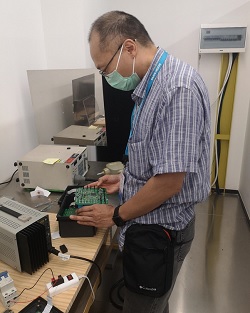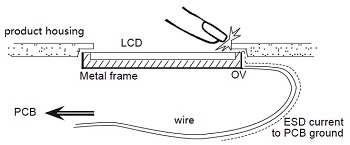TFT LCD Display and ESD
TFT LCD display is an ESD susceptible part within an electronic device. Electrostatic Discharge (ESD) is the sudden flow of electricity between two electrically charged objects caused by contact, an electrical short, or dielectric breakdown.
The Incident
We have this power grid device manufacture in Eastern China, who picks Topway as the TFT LCD display supplier for new circuit breaker project. The new circuit breaker's TFT LCD screen is LMT035DNJFWD-NNA with resistive touch screen.
For a new electrical circuit breaker, certification process is very stringent. One day, the client asked Topway for on-site support. Their new circuit breaker fails ESD Class 3 (4KV~8KV discharge) test. During the test, LCD screen turns dark and becomes unresponsive. Disconnect then re-connect power supply is the only way to bring TFT LCD display back online.
Analysis and Solution
Our Chief Engineer, Kenny took over the case and he was on a plane to Shanghai the next day.
Circuit damage from ESD can occur as a result of three effects: (1) High current heating, which destroys junctions or metallization. (2) Intense electromagnetic fields, which break down junctions or thin oxides. (3) Radiated noise, which drives the circuit into invalid or locked up states.
Based on customer's feed back and on-site analyzing, Kenny narrows down the culprit to radiated noise. Two modification suggestions are discussed with client's engineers: Increase grounding contact area of TFT LCD metal frame to product PCB; Enlarge "floating" gap between circuit breaker housing and TFT touch screen.
Changes are implemented quickly. The new circuit breaker successfully passed all ESD tests and was granted certification.

ESD Protection of TFT LCD
TFT LCD display is vulnerable to EMI & ESD, especially with built-in touch screen. Checkout this post about LCD & EMI. As for ESD, TFT LCD display is mounted flush on an equipment façade. A discharge can reach the edge of the LCD frame, not fully released by product housing.

Making things complicated, the LCD frame is often connected to product PCB's signal Gnd. Thus, the full discharge current can flow to equipment board. The solutions depend on finished product, conductive or non-conductive housing.
With metallic (conductive) housing:
- a tight electrical bond on all sides, between the LCD frame and the aperture stepped edge.
- a transparent conductive overlay such as ITO (Indium Tin Oxide); surface resistance, covering all the way to aperture stepped edge.
With non-conductive housing:
The TFT LCD display is sacrificed as entry point for ESD. Use a shielded flat cable, connect LCD frame to PCB ground; Increase insulation gap(float) between product housing and LCD display module.
